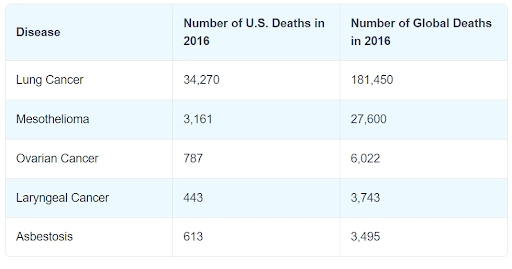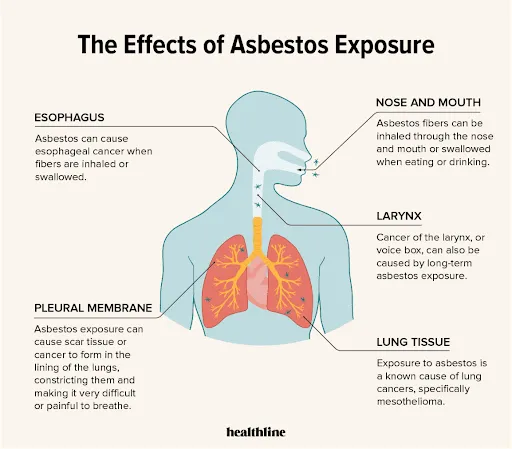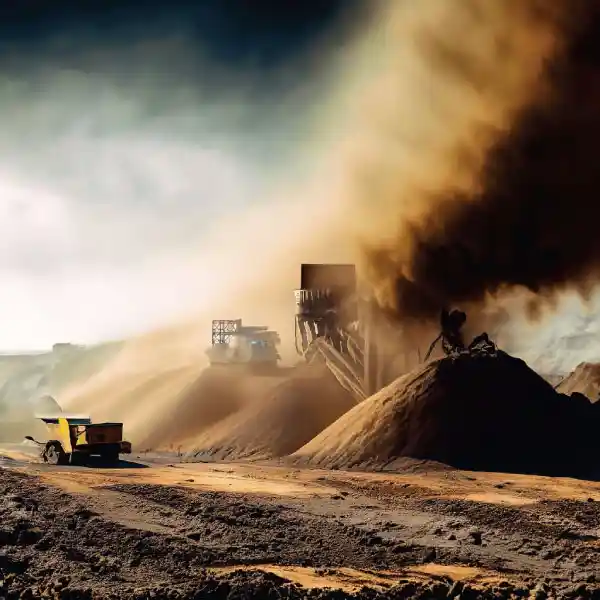Asbestos emerged as a problematic element in modern construction and industrial times. Initially admired for its adaptability and extraordinary fire-resistance capabilities, this ubiquitous mineral is today identified as a hidden opponent, damaging our planet’s health and ecological balance. Asbestos, a naturally occurring fibrous material once widely used in various construction and industrial applications, has evolved into a silent but formidable threat, silently ingrained in the structures we inhabit and the air we breathe.
The danger of asbestos lies in its widespread use and microscopic form, invisible to the naked eye. What does asbestos dust look like is a crucial question, as these minuscule asbestos fibres, when inhaled, become a severe health hazard, capable of lodging deep within the respiratory system. The consequences are terrible and often delayed, leading to debilitating illnesses such as mesothelioma, a lethal form of cancer. The insidious nature of asbestos-related diseases is further exacerbated by their long latency period. Symptoms may remain dormant, manifesting decades after initial exposure, cloaking the true extent of the threat.
The environmental repercussions of asbestos are just as alarming. The extraction and processing of this mineral generate substantial quantities of hazardous waste, spreading contamination across soil, water, and air. As materials containing asbestos age and deteriorate, they release these harmful fibres into our surroundings, endangering human health and wildlife.
In this comprehensive blog, we embark on an explorative journey into asbestos. We will examine its microscopic appearance, unravel its identifying characteristics, and map its prevalent locations. Our exploration extends to the profound environmental and health implications of asbestos exposure. We aim to illuminate the potential risks associated with this material, emphasising the critical need for accurate identification and effective remediation.
According to a 2023 report by the U.S. Geological Survey, global consumption of asbestos ranged from 1.1 to 1.3 million tons per year from 2015 through 2021.
A 2018 study reported that asbestos-related diseases killed 39,275 people in the U.S. and 222,321 people throughout the world in 2016.

How to Identify Asbestos?
Asbestos, once present everywhere, is a component in construction and industrial materials and has now emerged as a hidden threat in our daily environments. This naturally occurring mineral, composed of fine, durable fibres, is nearly invisible to the naked eye yet poses significant health risks when airborne and inhaled, leading to severe respiratory illnesses, including the deadly mesothelioma.
Microscopic Appearance
At the microscopic level, asbestos fibres are exceedingly thin, resembling thread-like structures. They come in different colours, predominantly white, brown, and blue. They are so small, measuring less than 0.5 micrometres in width, that they can quickly become airborne and remain suspended for prolonged periods. This ability to stay in the air contributes significantly to their hazardous nature, as they can be inhaled deeply into the lungs.
White asbestos (chrysotile):
The most prevalent type, chrysotile, accounts for up to 90% of asbestos used globally, or white asbestos, which is commonly found in insulation, ceiling tiles, and joint compounds and is also the only member of the serpentine family of asbestos. Under a microscope, it appears as a white, fluffy substance, often intertwined with other materials, making it challenging to identify.
Brown asbestos (amosite):
As a member of the amphibole family, often used mainly in pipe insulation, roofing shingles, and fireproofing materials, amosite or brown asbestos has a brown, fibrous texture. Its rugged appearance often resembles rock wool insulation, necessitating expert analysis for accurate identification.
Blue asbestos (crocidolite):
Like amosite asbestos, they are also part of the amphibole family; Crocidolite, or blue asbestos, is less common but highly hazardous. It is primarily found in electrical insulation and gaskets and is identifiable by its distinctive blue-grey colour and grainy texture.
Colour and Texture
While the colour and texture of asbestos can provide initial clues to its presence, it’s crucial to acknowledge the limitations of visual identification. Asbestos-containing materials (ACMs) can vary widely in appearance, making it difficult to confirm the presence of asbestos without professional assessment and laboratory testing.
Widespread Locations: Where to Be Mindful
Asbestos’s historical use in various applications makes it a widespread concern, especially in older structures and materials:
Construction Sites:
- Buildings constructed before the 1980s are particularly susceptible to containing asbestos in insulation, shingles, siding, flooring, and wallboard.
- Industrial Settings: Asbestos’s fire-resistant and insulating properties led to its widespread use in industrial applications, including pipe and boiler insulation, electrical insulation, and brake pads.
- Residential Areas: In homes, especially older constructions, asbestos may be present in popcorn or acoustic ceilings, vinyl flooring, and textured paints.
The Indispensable Role of Laboratory Testing
Recognising the limitations of visual inspection, laboratory testing is vital for the definitive identification of asbestos. This process involves microscopic analysis of suspected materials, enabling a precise and reliable assessment. This step is essential for informed decision-making regarding managing and remedying asbestos-containing materials.
While colour and texture can indicate asbestos presence, it is crucial to emphasise that visual inspection alone is not a reliable means of definitive identification. Asbestos-containing materials can vary significantly in appearance, and even experienced professionals rely on laboratory testing for confirmation.
The colour and texture of asbestos can be altered by factors such as age, weathering, and contamination, making visual inspection even more challenging. Additionally, some asbestos-containing materials may not exhibit any distinctive colour or texture, further complicating identification.
Where is Asbestos found?
The pervasive nature of asbestos in various settings makes awareness and proper identification crucial for our safety.
Russia is the world’s largest asbestos producer, with an annual production of around 700,000 million metric tons in 2022. This mineral is found naturally in the environment and contains silicon and oxygen. It occurs in different colours, such as blue, brown, and white, and is usually seen as a fibrous material.
Construction Sites
Construction sites, especially older structures built before the 1980s, are standard repositories of asbestos-containing materials.
- Insulation: Asbestos was the insulation material of choice for pipes, boilers, and walls, valued for its heat-resistant properties.
- Roofing Shingles: Asbestos-cement shingles, known for their durability and fire resistance, were widely used in roofing.
- Siding: The strength and weather resistance of asbestos siding made it a popular choice in building exteriors.
- Flooring: Vinyl tiles containing asbestos were favoured for their durability and ease of maintenance.
Wallboard: Known as “Transite,” asbestos-cement wallboard was preferred for its fire resistance and strength.
Each of these applications poses a risk due to the potential release of asbestos fibres during renovations, demolitions, or deterioration.
Industrial Settings
In industrial environments, asbestos was utilised for its fire-resistant and insulating properties.
- Pipe Insulation: Asbestos was a common insulator for pipes and boilers, particularly in high-temperature settings.
- Electrical Insulation: Electrical wiring and components were often insulated with asbestos to prevent fires.
- Brake Pads: The heat resistance of asbestos made it an ideal material for brake pads in vehicles and machinery.
- Gaskets and Seals: Its ability to withstand high temperatures and pressures led to the use of asbestos in gaskets and seals.
- Fireproofing Materials: Asbestos was a go-to material for fireproofing due to its resistance to heat and flames.
Asbestos in these applications presents health risks, especially when materials are disturbed or worn down.
Residential Areas
Asbestos also found its way into many homes, commonly in materials like
- Popcorn or acoustic Ceiling. Used for its texturing ability and sound insulation, asbestos was a frequent component in popcorn ceilings.
- Vinyl Flooring: Similar to its use in industrial settings, asbestos-containing vinyl tiles were popular in residential flooring.
- Textured Paint: Asbestos was added to paints for various decorative finishes.
- Joint Compounds: Used to fill and seal drywall gaps, asbestos was a common ingredient in joint compounds.
- Putty and Patching Compounds: Asbestos-containing compounds were used to repair wall and ceiling imperfections.
These residential uses of asbestos pose significant risks, especially during remodelling or if the materials are damaged.
The Importance of Awareness and Professional Guidance
Given the health risks posed by asbestos, it’s crucial to approach suspected asbestos-containing materials cautiously. If you suspect the presence of asbestos in your home or workplace, it’s imperative to consult a qualified professional for proper assessment and remediation. Remember, visual inspection is not sufficient to identify asbestos. Laboratory testing is necessary for a definitive identification and to guide the appropriate response.

Conclusion
As we conclude our exploration into the realm of asbestos, a mineral once celebrated for its utility but now recognised as a formidable health and environmental hazard, it becomes evident that addressing the challenges it poses including the critical Role of Asbestos Dust Monitoring, is not just an individual endeavour but a collective responsibility. Our commitment as environmental experts extend beyond raising awareness; it involves advocating for responsible asbestos management practices and empowering individuals to safeguard their health and well-being.
The Environmental Impact: A Call for Responsible Management
Asbestos endangers human health and poses a substantial environmental threat. Mining and refining asbestos and deteriorating asbestos-containing materials release hazardous waste, contaminating soil, water, and air. This environmental degradation requires responsible and sustainable management practices to mitigate its impact.
Empowering Individuals: Taking Charge of Your Health
To protect against asbestos exposure, individual action is paramount.
Educate Yourself: Understanding asbestos’s appearance and common locations is critical to early detection and prevention.
Consult a Professional: If you suspect asbestos in your environment, seeking expert advice for proper assessment and management is crucial.
Monitor Indoor Air Quality: Tools like Oizom air monitors can help detect airborne asbestos particles, ensuring a safer indoor environment.
A Collective Effort: Towards a Healthier Future
Tackling the asbestos issue demands collaboration among individuals, businesses, and policymakers. Together, we can transform asbestos from a silent threat into a well-managed hazard. As environmental advocates, we are dedicated to promoting innovative technologies for asbestos detection and remediation and providing the knowledge necessary for people to make informed decisions about their health.
Together, we can envision and work towards a future where the threat of asbestos is a thing of the past, ensuring our present and future are safeguarded from its legacy. Our collective efforts can lead to a world where health and environmental safety are paramount and the risks associated with asbestos are effectively contained and managed.
FAQs:
Answer: No, asbestos dust is not visible to the naked eye. Asbestos fibres are tiny, with diameters less than 0.5 micrometres. This microscopic size means that asbestos dust can quickly become airborne and remain suspended, making it particularly hazardous as it can be inhaled without detection. Professional testing and microscopic examination are required to identify the presence of asbestos fibres in materials or the air.
Answer: Asbestos dust does not have a distinct colour that can be visually identified, as the fibres are too small to be seen individually by the naked eye. Asbestos, in its solid form, before it is broken down into dust, can come in various colours depending on its type. For instance, chrysotile asbestos is typically white, amosite asbestos is usually brown, and crocidolite asbestos often appears blue. However, once these materials are reduced to dust, their colour cannot be used as a reliable means of identification.
Answer: Yes, Polarized Light Microscopy (PLM) is a standard method to detect asbestos in dust samples. PLM involves using a particular type of microscope to analyse the optical properties of asbestos fibres. This method can determine the presence and type of asbestos in a sample. PLM is beneficial for identifying asbestos in bulk materials. However, Transmission Electron Microscopy (TEM) is often considered a more precise method for airborne asbestos fibres found in dust due to its higher magnification and ability to analyse smaller fibres.
Asbestos dust can cause serious health issues when inhaled, including lung disease, respiratory problems, and cancers like mesothelioma and lung cancer.
Not all asbestos dust is cancerous, but exposure to any form of asbestos dust increases the risk of developing cancer and other serious respiratory conditions over time.






